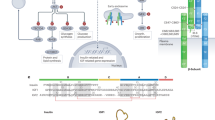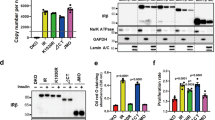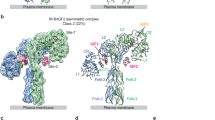Abstract
Mammalian target of rapamycin (mTOR) is a core component of raptor-mTOR (mTORC1) and rictor-mTOR (mTORC2) complexes that control diverse cellular processes. Both mTORC1 and mTORC2 regulate several elements downstream of type I insulin-like growth factor receptor (IGF-IR) and insulin receptor (InsR). However, it is unknown whether and how mTOR regulates IGF-IR and InsR themselves. Here we show that mTOR possesses unexpected tyrosine kinase activity and activates IGF-IR/InsR. Rapamycin induces the tyrosine phosphorylation and activation of IGF-IR/InsR, which is largely dependent on rictor and mTOR. Moreover, mTORC2 promotes ligand-induced activation of IGF-IR/InsR. IGF- and insulin-induced IGF-IR/InsR phosphorylation is significantly compromised in rictor-null cells. Insulin receptor substrate (IRS) directly interacts with SIN1 thereby recruiting mTORC2 to IGF-IR/InsR and promoting rapamycin- or ligand-induced phosphorylation of IGF-IR/InsR. mTOR exhibits tyrosine kinase activity towards the general tyrosine kinase substrate poly(Glu-Tyr) and IGF-IR/InsR. Both recombinant mTOR and immunoprecipitated mTORC2 phosphorylate IGF-IR and InsR on Tyr1131/1136 and Tyr1146/1151, respectively. These effects are independent of the intrinsic kinase activity of IGF-IR/InsR, as determined by assays on kinase-dead IGF-IR/InsR mutants. While both rictor and mTOR immunoprecitates from rictor+/+ MCF-10A cells exhibit tyrosine kinase activity towards IGF-IR and InsR, mTOR immunoprecipitates from rictor−/− MCF-10A cells do not induce IGF-IR and InsR phosphorylation. Phosphorylation-deficient mutation of residue Tyr1131 in IGF-IR or Tyr1146 in InsR abrogates the activation of IGF-IR/InsR by mTOR. Finally, overexpression of rictor promotes IGF-induced cell proliferation. Our work identifies mTOR as a dual-specificity kinase and clarifies how mTORC2 promotes IGF-IR/InsR activation.
Similar content being viewed by others
Log in or create a free account to read this content
Gain free access to this article, as well as selected content from this journal and more on nature.com
or
References
Kim J, Kundu M, Viollet B, Guan KL . AMPK and mTOR regulate autophagy through direct phosphorylation of Ulk1. Nat Cell Biol 2011; 13:132–141.
Laplante M, Sabatini DM . mTOR signaling in growth control and disease. Cell 2012; 149:274–293.
Ben-Sahra I, Howell JJ, Asara JM, Manning BD . Stimulation of de novo pyrimidine synthesis by growth signaling through mTOR and S6K1. Science 2013; 339:1323–1328.
Robitaille AM, Christen S, Shimobayashi M, et al. Quantitative phosphoproteomics reveal mTORC1 activates de novo pyrimidine synthesis. Science 2013; 339:1320–1323.
Jacinto E, Loewith R, Schmidt A, et al. Mammalian TOR complex 2 controls the actin cytoskeleton and is rapamycin insensitive. Nat Cell Biol 2004; 6:1122–1128.
Sarbassov DD, Guertin DA, Ali SM, Sabatini DM . Phosphorylation and regulation of Akt/PKB by the rictor-mTOR complex. Science 2005; 307:1098–1101.
Sarbassov DD, Ali SM, Sengupta S, et al. Prolonged rapamycin treatment inhibits mTORC2 assembly and Akt/PKB. Mol Cell 2006; 22:159–168.
Garcia-Martinez JM, Alessi DR . mTOR complex 2 (mTORC2) controls hydrophobic motif phosphorylation and activation of serum- and glucocorticoid-induced protein kinase 1 (SGK1). Biochem J 2008; 416:375–385.
Guertin DA, Stevens DM, Thoreen CC, et al. Ablation in mice of the mTORC components raptor, rictor, or mLST8 reveals that mTORC2 is required for signaling to Akt-FOXO and PKCalpha, but not S6K1. Dev Cell 2006; 11:859–871.
Dibble CC, Asara JM, Manning BD . Characterization of Rictor phosphorylation sites reveals direct regulation of mTOR complex 2 by S6K1. Mol Cell Biol 2009; 29:5657–5670.
Julien LA, Carriere A, Moreau J, Roux PP . mTORC1-activated S6K1 phosphorylates Rictor on threonine 1135 and regulates mTORC2 signaling. Mol Cell Biol 2010; 30:908–921.
Liu P, Gan W, Inuzuka H, et al. Sin1 phosphorylation impairs mTORC2 complex integrity and inhibits downstream Akt signalling to suppress tumorigenesis. Nat Cell Biol 2013; 15:1340–1350.
Kinkade CW, Castillo-Martin M, Puzio-Kuter A, et al. Targeting AKT/mTOR and ERK MAPK signaling inhibits hormone-refractory prostate cancer in a preclinical mouse model. J Clin Invest 2008; 118:3051–3064.
O'Reilly KE, Rojo F, She QB, et al. mTOR inhibition induces upstream receptor tyrosine kinase signaling and activates Akt. Cancer Res 2006; 66:1500–1508.
Brown J, Jones EY, Forbes BE . Keeping IGF-II under control: lessons from the IGF-II-IGF2R crystal structure. Trends Biochem Sci 2009; 34:612–619.
Pollak M . The insulin and insulin-like growth factor receptor family in neoplasia: an update. Nat Rev Cancer 2012; 12:159–169.
Pollak M . Insulin and insulin-like growth factor signalling in neoplasia. Nat Rev Cancer 2008; 8:915–928.
Hsu PP, Kang SA, Rameseder J, et al. The mTOR-regulated phosphoproteome reveals a mechanism of mTORC1-mediated inhibition of growth factor signaling. Science 2011; 332:1317–1322.
Yu Y, Yoon SO, Poulogiannis G, et al. Phosphoproteomic analysis identifies Grb10 as an mTORC1 substrate that negatively regulates insulin signaling. Science 2011; 332:1322–1326.
Dai N, Christiansen J, Nielsen FC, Avruch J . mTOR complex 2 phosphorylates IMP1 cotranslationally to promote IGF2 production and the proliferation of mouse embryonic fibroblasts. Genes Dev 2013; 27:301–312.
Dai N, Rapley J, Angel M, Yanik MF, Blower MD, Avruch J . mTOR phosphorylates IMP2 to promote IGF2 mRNA translation by internal ribosomal entry. Genes Dev 2011; 25:1159–1172.
Cybulski N, Polak P, Auwerx J, Ruegg MA, Hall MN . mTOR complex 2 in adipose tissue negatively controls whole-body growth. Proc Natl Acad Sci USA 2009; 106:9902–9907.
Kumar A, Lawrence JC, Jr., Jung DY, et al. Fat cell-specific ablation of rictor in mice impairs insulin-regulated fat cell and whole-body glucose and lipid metabolism. Diabetes 2010; 59: 1397–1406.
Kim SJ, DeStefano MA, Oh WJ, et al. mTOR complex 2 regulates proper turnover of insulin receptor substrate-1 via the ubiquitin ligase subunit Fbw8. Mol Cell 2012; 48:875–887.
Hernandez-Sanchez C, Blakesley V, Kalebic T, Helman L, LeRoith D . The role of the tyrosine kinase domain of the insulin-like growth factor-I receptor in intracellular signaling, cellular proliferation, and tumorigenesis. J Biol Chem 1995; 270:29176–29181.
Lopaczynski W, Terry C, Nissley P . Autophosphorylation of the insulin-like growth factor I receptor cytoplasmic domain. Biochem Bioph Res Commun 2000; 279:955–960.
Vilella-Bach M, Nuzzi P, Fang Y, Chen J . The FKBP12-rapamycin-binding domain is required for FKBP12-rapamycin-associated protein kinase activity and G1 progression. J Biol Chem 1999; 274:4266–4272.
Gan X, Wang J, Su B, Wu D . Evidence for direct activation of mTORC2 kinase activity by phosphatidylinositol 3,4,5-trisphosphate. J Biol Chem 2011; 286:10998–11002.
Dhanasekaran N, Premkumar Reddy E . Signaling by dual specificity kinases. Oncogene 1998; 17:1447–1455.
Heitman J, Movva NR, Hall MN . Targets for cell cycle arrest by the immunosuppressant rapamycin in yeast. Science 1991; 253:905–909.
Brown EJ, Albers MW, Shin TB, et al. A mammalian protein targeted by G1-arresting rapamycin-receptor complex. Nature 1994; 369:756–758.
Hong F, Larrea MD, Doughty C, Kwiatkowski DJ, Squillace R, Slingerland JM . mTOR-raptor binds and activates SGK1 to regulate p27 phosphorylation. Mol Cell 2008; 30:701–711.
Bentzinger CF, Romanino K, Cloetta D, et al. Skeletal muscle-specific ablation of raptor, but not of rictor, causes metabolic changes and results in muscle dystrophy. Cell Metab 2008; 8:411–424.
Hresko RC, Mueckler M . mTOR. RICTOR is the Ser473 kinase for Akt/protein kinase B in 3T3-L1 adipocytes. J Biol Chem 2005; 280:40406–40416.
Feldman ME, Apsel B, Uotila A, et al. Active-site inhibitors of mTOR target rapamycin-resistant outputs of mTORC1 and mTORC2. PLoS Biol 2009; 7:e38.
Hoeffer CA, Klann E . mTOR signaling: at the crossroads of plasticity, memory and disease. Trends Neurosci 2010; 33:67–75.
Niessen M, Jaschinski F, Item F, McNamara MP, Spinas GA, Trub T . Insulin receptor substrates 1 and 2 but not Shc can activate the insulin receptor independent of insulin and induce proliferation in CHO-IR cells. Exp Cell Res 2007; 313:805–815.
Harrington LS, Findlay GM, Gray A, et al. The TSC1–2 tumor suppressor controls insulin-PI3K signaling via regulation of IRS proteins. J Cell Biol 2004; 166:213–223.
Um SH, Frigerio F, Watanabe M, et al. Absence of S6K1 protects against age- and diet-induced obesity while enhancing insulin sensitivity. Nature 2004; 431:200–205.
Briaud I, Dickson LM, Lingohr MK, McCuaig JF, Lawrence JC, Rhodes CJ . Insulin receptor substrate-2 proteasomal degradation mediated by a mammalian target of rapamycin (mTOR)-induced negative feedback down-regulates protein kinase B-mediated signaling pathway in beta-cells. J Biol Chem 2005; 280:2282–2293.
Wei F, Liu Y, Bellail AC, et al. K-Ras mutation-mediated IGF-1-induced feedback ERK activation contributes to the rapalog resistance in pancreatic ductal adenocarcinomas. Cancer Lett 2012; 322:58–69.
Naing A, LoRusso P, Fu S, et al. Insulin growth factor-receptor (IGF-1R) antibody cixutumumab combined with the mTOR inhibitor temsirolimus in patients with refractory Ewing's sarcoma family tumors. Clin Cancer Res 2012; 18:2625–2631.
Schwartz GK, Tap WD, Qin LX, et al. Cixutumumab and temsirolimus for patients with bone and soft-tissue sarcoma: a multicentre, open-label, phase 2 trial. Lancet Oncol 2013; 14:371–382.
Janes MR, Limon JJ, So L, et al. Effective and selective targeting of leukemia cells using a TORC1/2 kinase inhibitor. Nat Med 2010; 16:205–213.
Acknowledgements
We thank Prof Wei Zhang (Cancer Genomics Core Laboratory, MD Anderson Cancer Center, USA) for generously providing pcDNA3.1-IGF-IR plasmid. This work was supported by the intramural research funding from West China Hospital, Sichuan University, China.
Author information
Authors and Affiliations
Corresponding author
Additional information
( Supplementary information is linked to the online version of the paper on the Cell Research website.)
Supplementary information
Supplementary information, Figure S1
mTORC1 inhibition leads to mTORC2-dependent phosphorylation of IGF-IR/InsR. (PDF 1031 kb)
Supplementary information, Figure S2
Rictor and mTOR were required for IGF-IR/InsR phosphorylation resulting from rapamycin treatment and ligand stimulation. (PDF 593 kb)
Supplementary information, Figure S3
Western blot analysis of the efficacy and specificity of rictor, IRS1 and IRS2 knockdown. (PDF 219 kb)
Supplementary information, Figure S4
The effects of rapamycin, AICAR and insulin on IGF-IR/InsR-rictor-mTOR complexes. (PDF 287 kb)
Supplementary information, Figure S5
IRS1/2 promotes rapamycin-and ligand-induced phosphorylation of IGF-IR/InsR. (PDF 421 kb)
Supplementary information, Figure S6
Torin2 inhibits IGF/insulin signaling. (PDF 163 kb)
Supplementary information, Figure S7
The rictor immunoprecipitates induces kinase-dead IGF-IR (KD-IGF-IR) and InsR (KD-InsR) phosphorylation in vitro. (PDF 148 kb)
Supplementary information, Figure S8
mTOR promotes IGF-IR phosphorylation. (PDF 191 kb)
Supplementary information, Figure S9
Torin2 does not directly inhibit IGF-IR/InsR activity but inhibit mTOR-induced IGF-IR/InsR activation. (PDF 249 kb)
Supplementary information, Figure S10
In vitro kinase assays for the effects of mTOR on the activity of IGF-IR/InsR towards their substrate. (PDF 346 kb)
Supplementary information, Figure S11
Roles of PI3K in IGF-I- and rapamycin-induced IGF-IR/InsR phosphorylation. (PDF 146 kb)
Supplementary information, Figure S12
The effects of Ser/Thr phosphorylation and phosphatase inhibitors on IGF-IR/InsR tyrosine phosphorylation. (PDF 188 kb)
Supplementary information, Figure S13
mTOR induces tyrosine phosphorylation. (PDF 182 kb)
Supplementary information, Figure S14
The effects of mTOR and InsR on wild-type IGF-IR/InsR (WT-IGF-IR/InsR) peptide and mutated IGF-IR/InsR peptides. (PDF 275 kb)
Supplementary information, Figure S15
Mass spectrometric analysis of mTOR-induced phosphorylation in kinase-dead IGF-IR (K1033R). (PDF 490 kb)
Supplementary information, Figure S16
The effect of rapamycin and AG1024 on HepG2 cell proliferation. (PDF 120 kb)
Supplementary information, Table S1
Mass spectrometric identification of IGF-IR, InsR, IRS1, IRS2, mTOR and other proteins in rictor immunoprecipitates. (PDF 114 kb)
Supplementary information, Table S2
The molecular weight of proteins in western blot analysis. (PDF 133 kb)
Supplementary information, Data S1
Supplementary Methods (PDF 132 kb)
Rights and permissions
About this article
Cite this article
Yin, Y., Hua, H., Li, M. et al. mTORC2 promotes type I insulin-like growth factor receptor and insulin receptor activation through the tyrosine kinase activity of mTOR. Cell Res 26, 46–65 (2016). https://doi.org/10.1038/cr.2015.133
Received:
Revised:
Accepted:
Published:
Issue date:
DOI: https://doi.org/10.1038/cr.2015.133
Keywords
This article is cited by
-
Multifaceted role of mTOR (mammalian target of rapamycin) signaling pathway in human health and disease
Signal Transduction and Targeted Therapy (2023)
-
CircCASC15-miR-100-mTOR may influence the cervical cancer radioresistance
Cancer Cell International (2022)
-
Complementary roles of surgery and systemic treatment in clear cell renal cell carcinoma
Nature Reviews Urology (2022)
-
Comparison of dual mTORC1/2 inhibitor AZD8055 and mTORC1 inhibitor rapamycin on the metabolism of breast cancer cells using proton nuclear magnetic resonance spectroscopy metabolomics
Investigational New Drugs (2022)
-
14-3-3β is essential for milk composition stimulated by Leu/IGF-1 via IGF1R signaling pathway in BMECs
In Vitro Cellular & Developmental Biology - Animal (2022)



